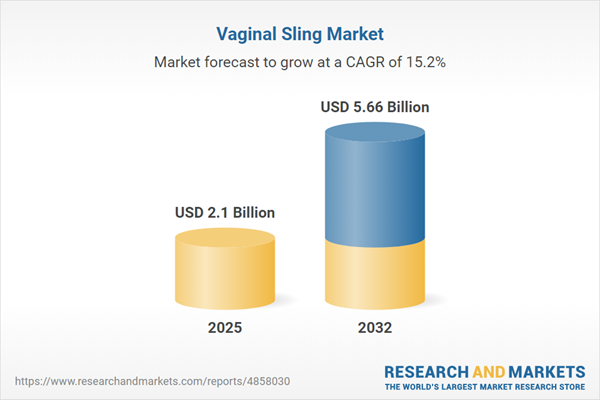Speak directly to the analyst to clarify any post sales queries you may have.
Senior healthcare executives are navigating a rapidly evolving landscape in the vaginal sling devices market, where regulatory shifts, new technologies, and changing clinical practices are redefining how organizations approach procurement, investment, and supplier relationships. In this climate, focused market intelligence is essential for data-driven decision-making and sustainable growth.
Market Snapshot: Vaginal Sling Devices
The vaginal sling devices market expanded from USD 1.82 billion in 2024 to USD 2.10 billion in 2025, with growth projected to reach USD 5.66 billion by 2032 and a compound annual growth rate (CAGR) of 15.17%.
These advances are fueled by the adoption of advanced mesh technologies and heightened global demand for stress urinary incontinence procedures. Industry diversification, adaptive product portfolios, and compliance with dynamic reimbursement and regulatory frameworks are shaping regional opportunities in North America, Europe, Asia-Pacific, and beyond.Scope & Segmentation
- Product Types: Mid urethral slings—including retropubic, single incision, and transobturator solutions—are offered alongside traditional allograft and autologous tissue slings to address diverse surgical requirements.
- Applications: Designed for both pelvic organ prolapse and stress urinary incontinence, these devices accommodate varied clinical protocols and patient customization needs across care environments.
- Material Types: Use of polyester and polypropylene meshes underscores an industry focus on safety, biocompatibility, and mechanical strength to improve procedural outcomes and patient comfort.
- End Users: Primary adoption settings include hospitals, ambulatory surgical centers, and clinics delivering gynecology and urology services, each with unique priorities in procedure management and patient throughput.
- Geographic Regions: The market spans the Americas, Europe, Middle East, Africa, and Asia-Pacific, each influenced by region-specific regulations and health care standards; major countries addressed include the United States, Canada, Brazil, United Kingdom, Germany, Japan, China, and India.
- Company Profiles: The competitive landscape features Johnson & Johnson, Boston Scientific Corporation, Coloplast A/S, Becton, Dickinson and Company, Teleflex Incorporated, Endo International plc, Cook Medical LLC, Caldera Medical, B. Braun Melsungen AG, and Medtronic plc.
Key Takeaways for Senior Decision-Makers
- Minimally invasive technologies such as single-incision techniques are promoting faster recovery, increased procedural efficiency, and enhanced patient experiences that align with provider and clinician priorities.
- Innovations in biocompatible mesh materials and membrane design are improving surgeon confidence, supporting product differentiation, and encouraging cross-industry supplier collaboration for higher-value offerings.
- Expansion in digital health platforms is increasing opportunities for post-surgical monitoring while driving new services for device companies and care providers.
- Ongoing academic research and feedback from multicenter studies guide iterative product design and help accelerate the acceptance of new device solutions across diverse care settings.
- Differentiation among suppliers is increasingly measured by their ability to demonstrate robust clinical outcomes and cost-effectiveness within value-based healthcare purchasing frameworks.
- Adoption trends differ by setting: hospitals often lead with complex interventions, whereas clinics and ambulatory centers emphasize targeted procedures and operational efficiency.
Tariff Impact on Supply Chain & Pricing
Recent tariffs on medical device components in the United States are compelling manufacturers to revise sourcing and production strategies. Tactics such as dual-sourcing and nearshoring are being adopted to counter rising input costs and maintain supply reliability. Health systems and procurement leaders collaborate closely with suppliers, streamlining credentialing processes and adjusting to updated reimbursement policies. These developments highlight the critical role of agile supply chain management and ongoing communication between stakeholders in shaping pricing and operational direction.
Methodology & Data Sources
This analysis integrates direct interviews with urogynecologists, procurement executives, and other key decision-makers, alongside comprehensive review of peer-reviewed studies, regulatory filings, and proprietary datasets. Independent experts validate findings in workshops to ensure accuracy and real-world applicability for senior leadership.
Why This Report Matters
- Senior executives gain actionable insights to refine product offerings, anticipate shifts in reimbursement, and plan for evolving sourcing and supply chain models.
- In-depth regional and segment analysis equips organizations to pursue new markets, optimize investments, and establish enduring B2B partnerships for long-term value.
- Up-to-date intelligence clarifies emerging risks, helping teams proactively adjust growth plans amid changing healthcare and regulatory dynamics.
Conclusion
As the vaginal sling devices sector advances clinically and technologically, deliberate investment, collaborative approaches, and data-driven strategies will position organizations for sustained competitiveness and operational resilience.
Additional Product Information:
- Purchase of this report includes 1 year online access with quarterly updates.
- This report can be updated on request. Please contact our Customer Experience team using the Ask a Question widget on our website.
Table of Contents
3. Executive Summary
4. Market Overview
7. Cumulative Impact of Artificial Intelligence 2025
List of Figures
Samples

LOADING...
Companies Mentioned
The key companies profiled in this Vaginal Sling market report include:- Johnson & Johnson
- Boston Scientific Corporation
- Coloplast A/S
- Becton, Dickinson and Company
- Teleflex Incorporated
- Endo International plc
- Cook Medical LLC
- Caldera Medical, Inc.
- B. Braun Melsungen AG
- Medtronic plc
Table Information
| Report Attribute | Details |
|---|---|
| No. of Pages | 187 |
| Published | October 2025 |
| Forecast Period | 2025 - 2032 |
| Estimated Market Value ( USD | $ 2.1 Billion |
| Forecasted Market Value ( USD | $ 5.66 Billion |
| Compound Annual Growth Rate | 15.1% |
| Regions Covered | Global |
| No. of Companies Mentioned | 11 |









